The creator economy is booming, valued at $250 billion in 2024 and projected to hit $1.49 trillion by 2034. With over 207 million content creators globally, it’s reshaping how individuals earn, influence, and innovate online. However, only a small fraction, less than 2%, achieve expert-level reach, and just 5% treat it as a full-time job.
Despite the industry’s scaling up, 96% of creators earn under $ 100,000 annually, revealing stark financial disparities. Brand deals remain the top income source, though earnings are diversifying.
This article presents key statistics on the creator economy, including earnings, revenue streams, challenges, platform trends, and future growth prospects.
Creator Economy Statistics: Top Picks
- The creator economy was valued at $250 billion in 2024 and is projected to reach $1.49 trillion by 2034, growing at a 26.4% annual rate.
- There are 207 million content creators worldwide, but fewer than 2% have over 100,000 followers, making it challenging to reach a professional level.
- Only 5% of creators work full-time (40+ hours per week), while 63% spend 10 hours or less, meaning most do it part-time.
- About 96% of creators earn less than $100K annually, and only half of full-time creators make enough to support themselves.
- Brand deals are the biggest income source, used by 68.8% of creators, but sponsorship earnings have dropped in recent years.
Number Of Content Creators In The World
As of 2025, there are approximately 207 million content creators worldwide, making this one of the most dynamic and rapidly expanding industries.
Out of these:
- 200 million creators are actively producing content across various platforms.
- Over 2 million creators have reached the status of experts, commanding significant influence online.
- The United States alone has over 45 million professional content creators, reflecting its strong digital economy.
But what do these numbers really mean? Let’s break down the creator economy further.
Types of Creators In The Creator Economy
The vast majority of creators (over 160 million) fall into the Recreational and Semi-Pro categories, meaning they are still in the early stages of building an audience.
Only about 4 million creators (less than 2%) have a following of over 100K, showing that reaching professional or expert-level status is a significant achievement.
The jump from 10K to 100K followers (Pro level) is substantial, with only 41 million creators in this category compared to 139 million in the Semi-Pro category.
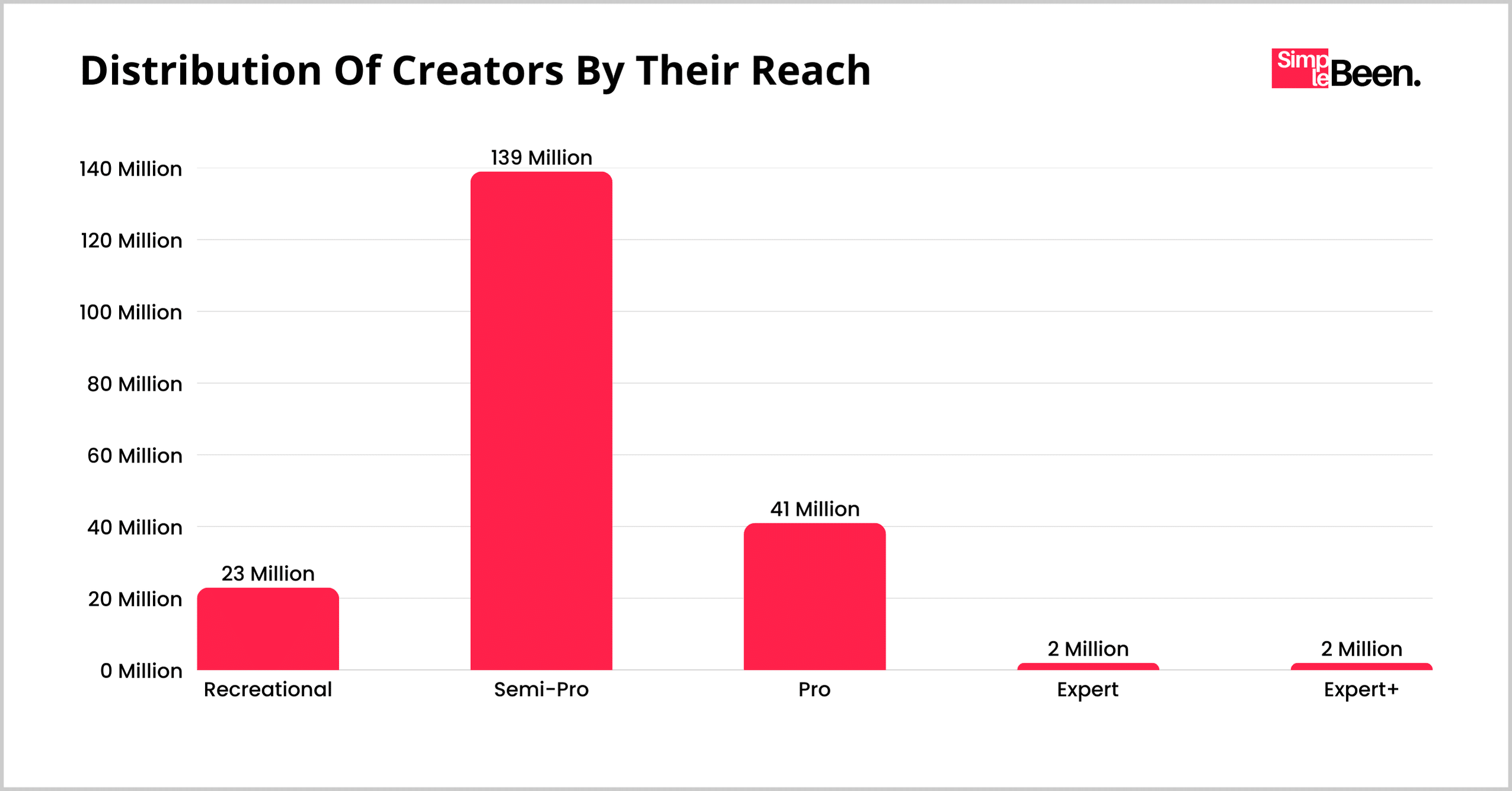
Content creators vary in influence, audience size, and commitment. The following categories illustrate how global creators are distributed based on their reach:
| Type of Influencer | Audience Size | Number of Creators |
|---|---|---|
| Recreational | 0 – 1K followers | 23 million |
| Semi-Pro | 1K – 10K followers | 139 million |
| Pro | 10K – 100K followers | 41 million |
| Expert | 100K – 1 million followers | 2 million |
| Expert+ | Over 1 million | 2 million |
Content Creation As A Career: Who Does It Full-Time?
A significant percentage of content creators have turned their passion into a profession. According to a survey by Converter Kit:
- 46.7% of creators consider content creation their full-time job.
- 40% of creators balance content creation with another job, treating it as a side hustle.
- Only 1 in 10 creators label themselves as hobbyists, meaning they create content purely for fun without any financial motivation.
This data highlights that while many creators are dedicated to their craft, only a fraction can rely entirely on content creation as their primary source of income.
How Much Time Do Creators Spend Making Content?
Only 5% of creators work full-time hours (40+ hours per week), meaning dedicated full-time creators are relatively rare.
A whopping 63% of creators spend 10 hours or less per week on content, indicating that content creation is mostly a part-time endeavor for the majority.
The most common time commitment is 1 to 5 hours per week, with over one-third (36%) of creators falling into this category.
Time commitment varies widely among creators. Some treat it as a side gig, while others devote full-time hours to producing high-quality content. According to Linktree, here’s how creators allocate their time:
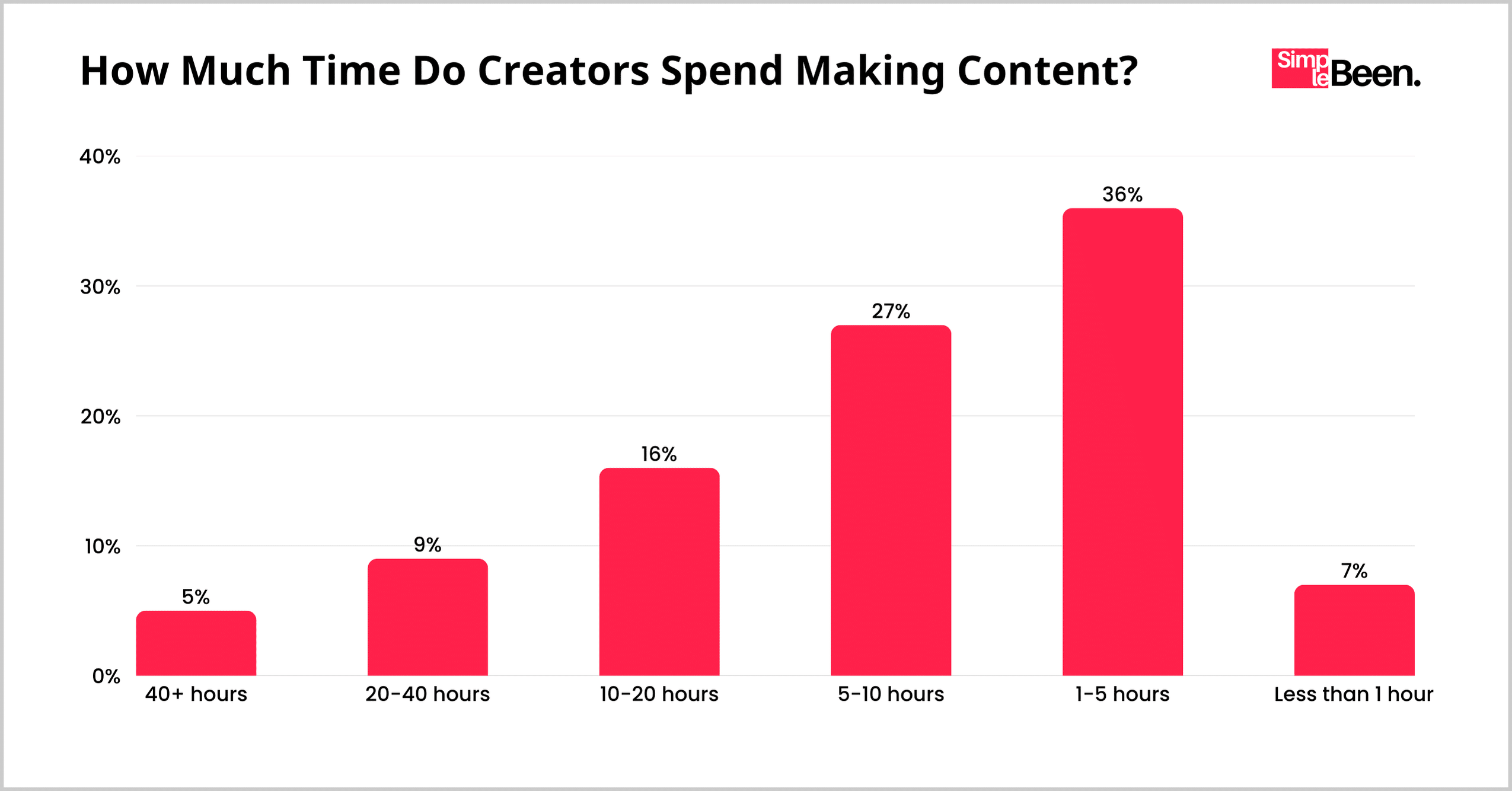
| Hours Spent Creating Each Week | Percentage of Creators |
|---|---|
| 40+ hours | 5% |
| 20-40 hours | 9% |
| 10-20 hours | 16% |
| 5-10 hours | 27% |
| 1-5 hours | 36% |
| Less than 1 hour | 7% |
Sources: Demandsage, Linktree, Converter Kit
Creator Economy Market Size
According to projections, the global creator economy is set to reach $1.49 trillion by 2034, a significant leap from $143 billion in 2024.
This represents a compound annual growth rate (CAGR) of 26.4% from 2025 to 2034.
North America leads the creator economy, with a 35.1% global market share. The United States alone contributes significantly, with a market valuation of $50.1 billion in 2024.
The fast-paced growth highlights increasing monetization opportunities for digital creators worldwide.
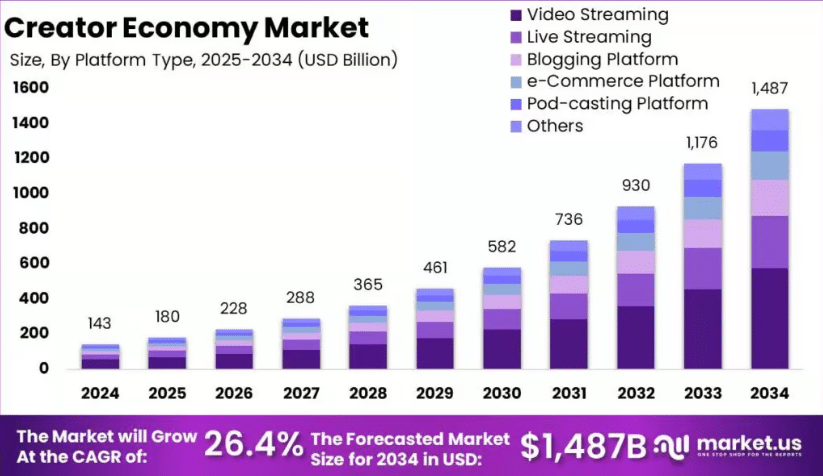
Content Creator Demographics
Who are the people behind the content we see every day? Content creators come from diverse backgrounds, ages, and locations, shaping the ever-growing digital world. Let’s take a closer look at who they are and how they contribute to the creator economy.
Gender Distribution Among Creators
A ConvertKit study revealed that most content creators are female, nearly twice the number of male creators.
Female creators dominate the industry, accounting for nearly two-thirds (64%) of all content creators. Meanwhile, male creators make up 35%, while 1% identify as non-binary or other.
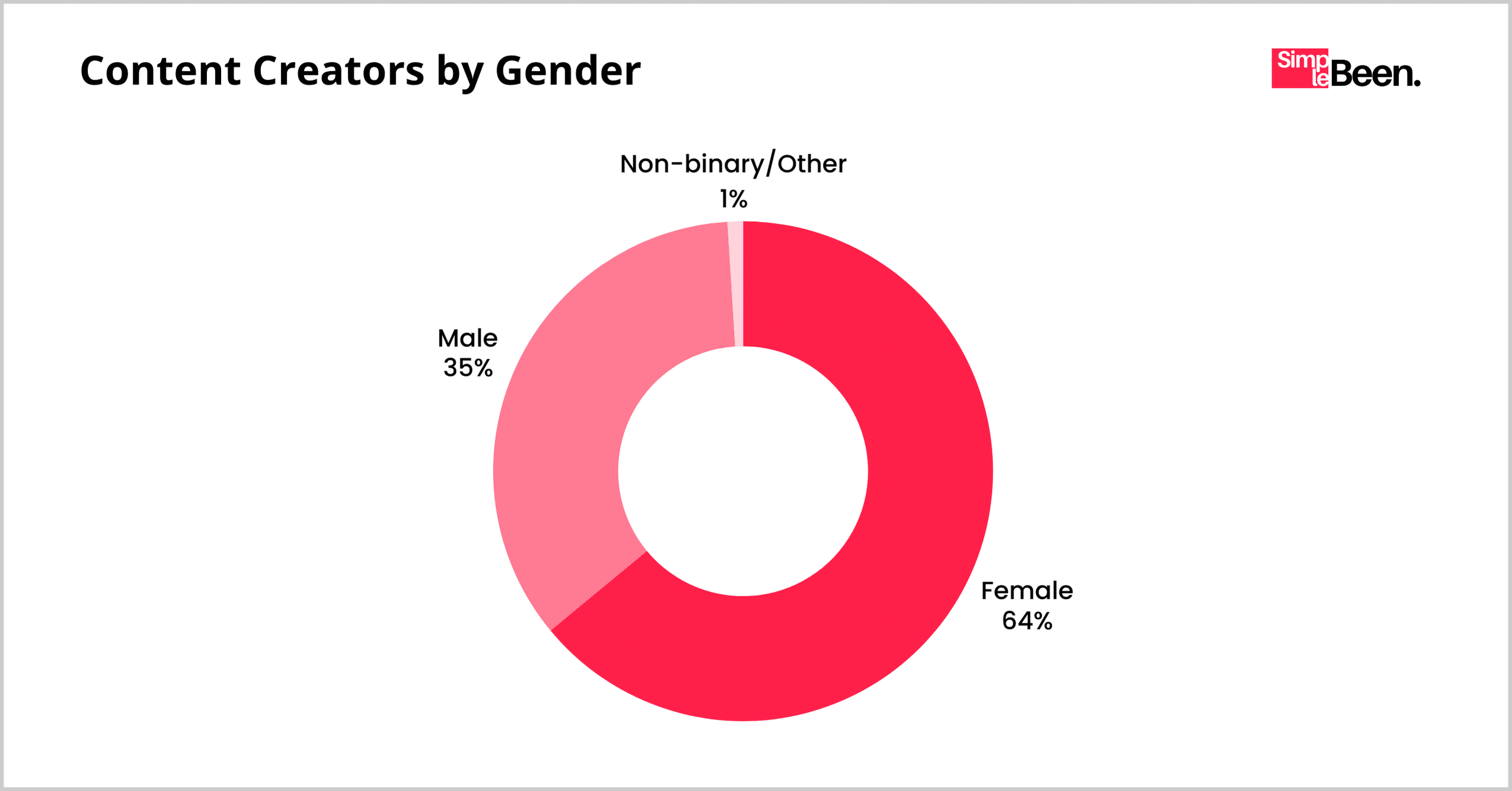
| Gender | Percentage of Creators |
|---|---|
| Female | 64% |
| Male | 35% |
| Non-binary/Other | 1% |
Source: ConvertKit Report
18% of both male and female creators earn over $100,000 annually.
Female creators have a slight edge in the mid-income range ($10K – $100K), while male creators are more likely to earn under $10K.
Non-binary creators show the highest percentage of high earners (20%) but also the highest percentage earning under $10K (70%).
Despite the gender gap in numbers, income distribution remains relatively balanced across genders.
| Gender | Earn Over $100K | Earn $10K – $100K | Earn Under $10K |
|---|---|---|---|
| Female | 18% | 22% | 60% |
| Male | 18% | 18% | 64% |
| Non-binary/Other | 20% | 10% | 70% |
Source: ConvertKit Report
Age And Ethnicity Of Content Creators In The U.S.
The largest age group consists of creators aged 30 and above, accounting for 70% of all U.S. creators.
Younger creators (20-30 years old) still make up a substantial 30% of the market. Besides, the average age of content creators in the U.S. is 36.6 years.
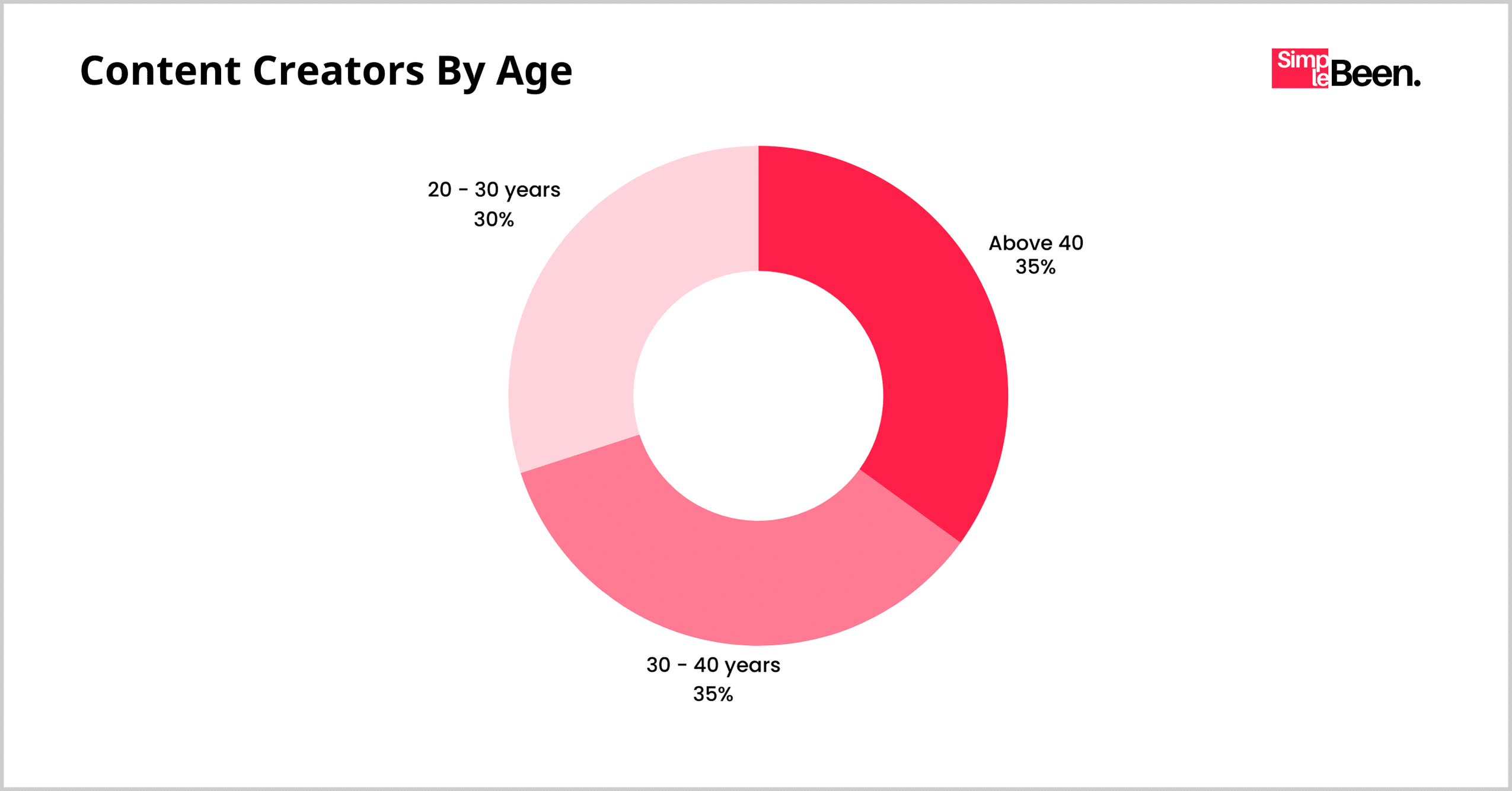
| Age Group | Percentage of Creators |
|---|---|
| Above 40 | 35% |
| 30 – 40 years | 35% |
| 20 – 30 years | 30% |
Source: Zippia Report
White creators make up the majority (67.2%), dominating the industry.
Hispanic/Latino creators (12.7%) and Asian creators (9.6%) represent the largest minority groups.
Black/African American creators make up 5.3%, while Indigenous creators remain underrepresented (0.2%).

| Ethnicity/Race | Percentage of U.S. Creators |
|---|---|
| White | 67.2% |
| Hispanic or Latino | 12.7% |
| Asian | 9.6% |
| Black or African American | 5.3% |
| Unknown | 5.0% |
| American Indian and Alaska Native | 0.2% |
Source: Zippia Report
How Much Do Content Creators Make?
The creator economy is expanding rapidly, but financial success varies widely. Here’s a closer look at how much content creators earn:
- Average annual salary: $44,000
- Hourly earnings: $22
- Monthly income: $3,680
- Typical salary range: $36,000 – $58,500
- Top earners’ income: Up to $74,500 per year
While some creators reach high earnings, most remain within a moderate income bracket.
Source: HubSpot
The Income Gap: Most Creators Earn Less Than $100K
While some content creators achieve financial independence, the majority struggle to earn a full-time income.
- 96% of creators earn below $100,000 annually
- 51% of full-time creators earn enough to sustain themselves
- 19% of full-time creators support multiple people
| Income Category | Percentage of Creators |
|---|---|
| Earning under $100K/year | 96% |
| Self-sufficient full-time creators | 51% |
| Supporting multiple dependents | 19% |
Source: Tilt
Creators earning less than $100K/year usually rely on two income streams
Successful creators diversify their revenue sources. The highest earners avoid relying on a single platform or monetization strategy.
Six-figure earners have at least five revenue sources. Those making over $150K/year leverage seven or more income streams
| Earnings Bracket | Typical Number of Revenue Streams |
|---|---|
| Below $100K/year | 2 |
| $100K – $150K/year | 5+ |
| Over $150K/year | 7+ |
Source: The Tilt
Content Creator Top Revenue Sources
The creator economy thrives on multiple revenue streams, with brand deals being the dominant income source. However, creators are diversifying their earnings across various channels.
- Nearly 7 in 10 (68.8%) creators rely on brand deals as their primary revenue stream.
- Ad revenue is the second most common source, but only 7.3% of creators claim it as their primary income.
- Other significant revenue sources include launching personal brands, affiliate marketing, and selling courses.
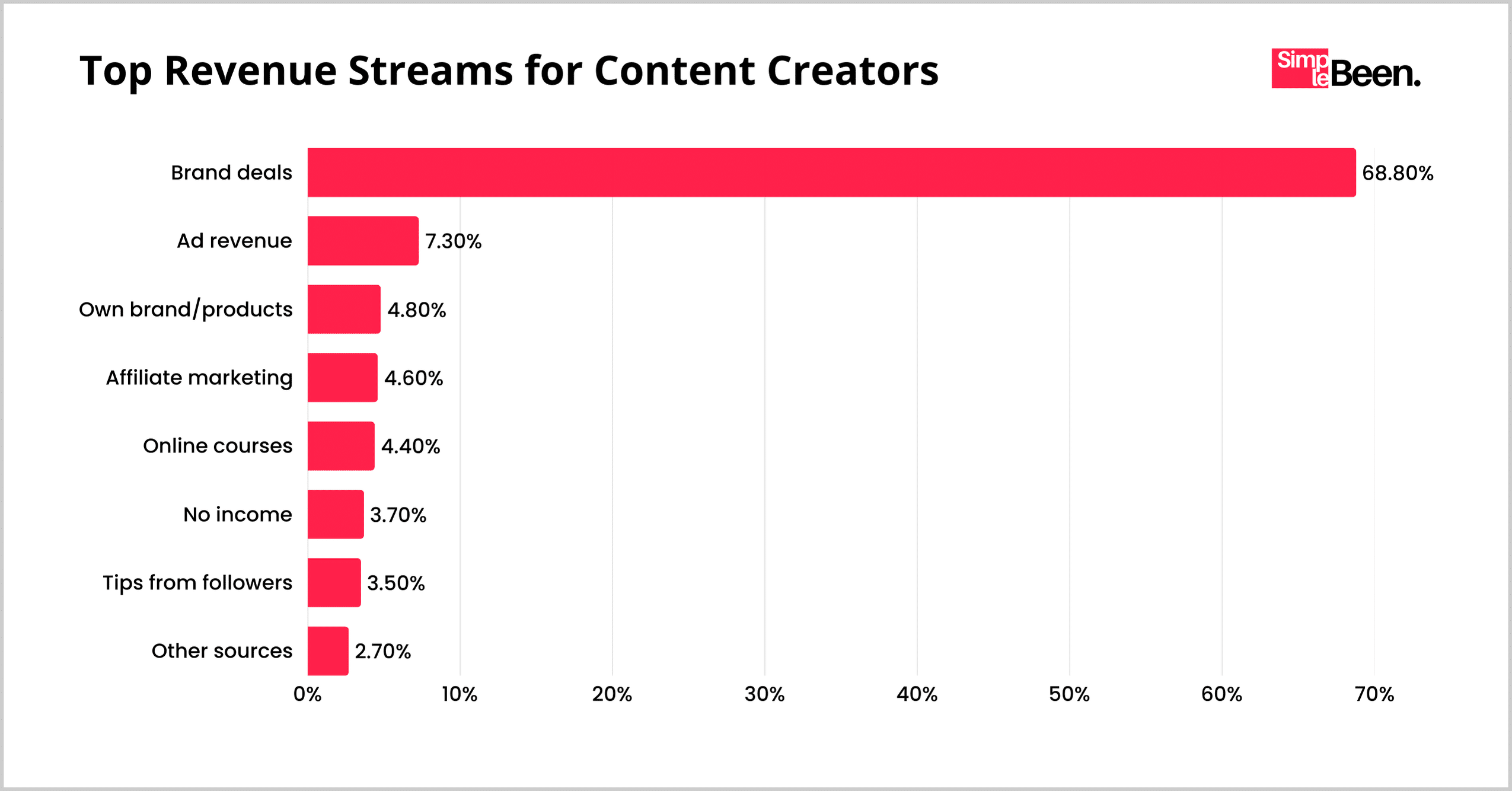
Top Revenue Streams for Content Creators:
| Rank | Revenue Source | Percentage of Creators |
|---|---|---|
| 1 | Brand deals | 68.8% |
| 2 | Ad revenue | 7.3% |
| 3 | Own brand/products | 4.8% |
| 4 | Affiliate marketing | 4.6% |
| 5 | Online courses | 4.4% |
| 6 | No income | 3.7% |
| 7 | Tips from followers | 3.5% |
| 8 | Other sources | 2.7% |
Sponsorship income has dropped from 91% in 2021 to 82% in 2023 (-9%)
While brand deals remain the top income source, fewer creators are relying solely on sponsorships compared to previous years, while alternative income sources such as affiliate marketing, ad revenue, and merchandise sales are growing.
On the other side, affiliate earnings have seen a 9% increase, while ad revenue has almost doubled, jumping from 18% to 33%. Merchandise sales have also experienced steady growth, rising by 4% over the past two years.
| Revenue Channel | 2021 | 2023 | Change |
|---|---|---|---|
| Sponsored content | 91% | 82% | – 9% |
| Affiliate marketing | 47% | 56% | +9% |
| Ad revenue | 18% | 33% | -15% |
| Creator funds | – | 25% | – |
| Paid subscriptions | – | 16% | – |
| Selling merchandise | 11% | 15% | +4% |
Merchandise-based companies are at the forefront of the creator economy, generating over $500 million annually.
Subscription services and blockchain technologies are also proving to be lucrative sectors. These businesses generate hundreds of millions annually by helping creators monetize their brands.
| Industry | Average Annual Revenue |
|---|---|
| Merchandise Sales | $511.69 million |
| Subscription Platforms | $308.11 million |
| Blockchain & Crypto Tools | $192.73 million |
| Ad Platforms | $47.01 million |
| Community & Analytics Tools | $35.8 million |
| Online Courses | $30.8 million |
| Content Creation Services | $20.73 million |
| Fan Engagement Platforms | $18.52 million |
| Admin & Analytics Tools | $13.32 million |
| SaaS for Creators | $9.95 million |
| Financing for Creators | $9.76 million |
| Link-in-Bio Tools | $7.97 million |
Sources: Goldman Sachs, eMarketer, NeoReach
Which Social Media Platform Pays The Most?
A survey of 1,500 content creators revealed that 30% consider TikTok their top source of income. YouTube follows closely, with 25.8% of creators saying it offers the best earnings.
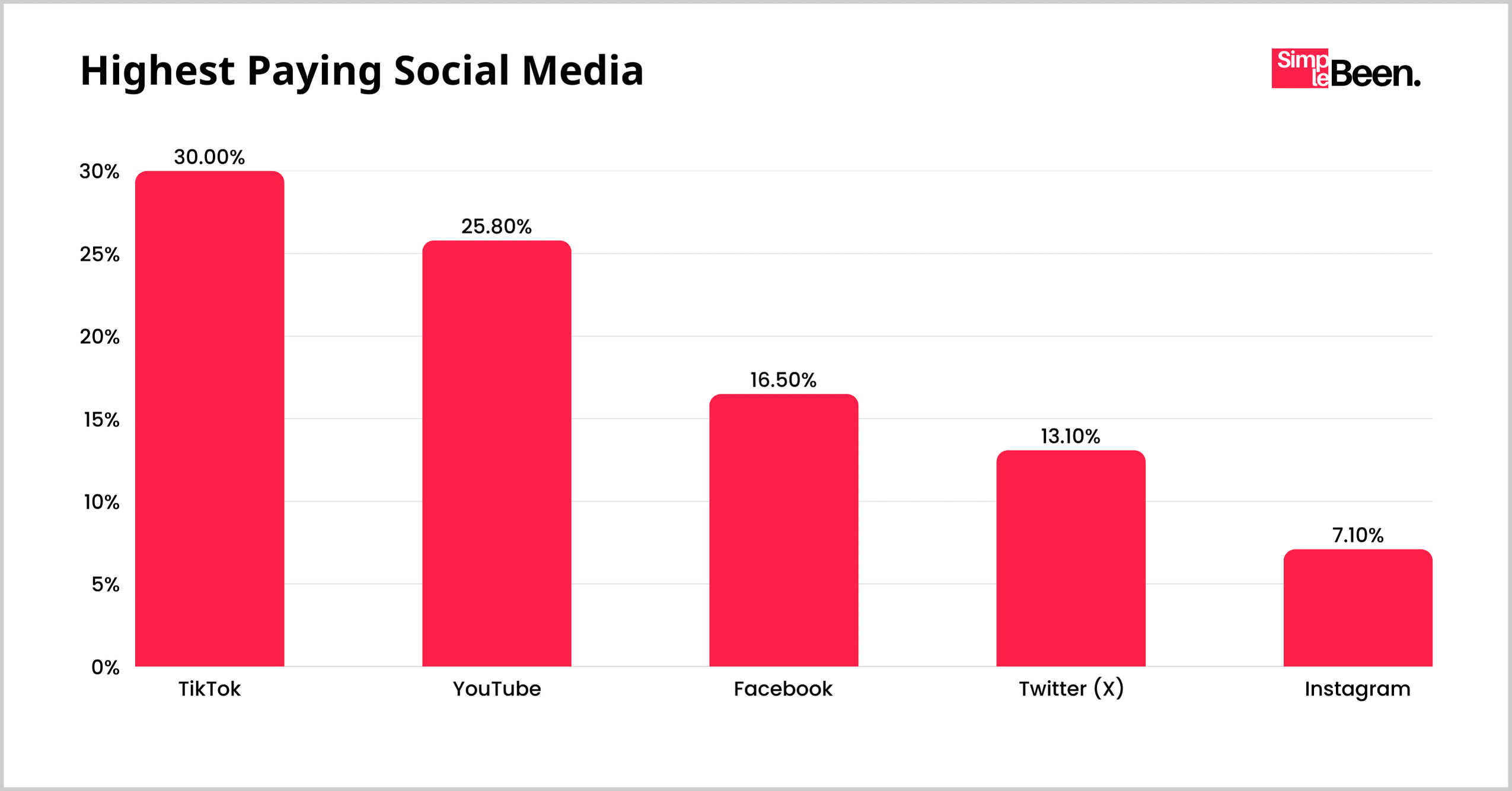
Here’s how creators rank the highest-paying social media platforms:
| Social Media Platform | Percentage of Creators Who Earn the Most Here |
|---|---|
| TikTok | 30% |
| YouTube | 25.8% |
| 16.5% | |
| Twitter (X) | 13.1% |
| 7.1% |
While TikTok dominates as the best-paying platform, YouTube remains a strong competitor. Meanwhile, platforms like Facebook, Twitter, and Instagram offer income opportunities but lag behind in overall earnings potential.
Did You Know? Fewer than 10% of creators on OnlyFans earned over $10,000 from their content in 2021. For more details, check out the complete OnlyFans statistics!
Creator Challenges Statistics
While the creator economy continues to grow, content creators face numerous challenges behind the scenes. From burnout and financial uncertainty to platform algorithm changes, staying successful in this space is no easy task.
Being a content creator isn’t just about making videos or writing posts; it’s a demanding job that can take a toll on mental health.
- 63% of full-time creators have experienced burnout in the past year.
- More than 45% say the pressure to be active on multiple platforms is a key cause.
- Content fatigue affects around 44% of creators.
- 13% of full-time creators and 9% of part-timers report experiencing extreme stress levels.
The constant demand to create and post content can be overwhelming, leading to high-stress levels and burnout.
In 2024, 58% of creators struggled with monetization, an improvement from 62% in 2023.
Despite the potential for financial success, making money as a creator is still a challenge. Meanwhile, 43% said balancing content creation with monetization was difficult.
Other everyday struggles included:
| Monetization Challenges | Percentage of Creators Affected |
|---|---|
| Limited audience & reach | 54% |
| Inconsistent income | 45% |
| Finding brand deals | 39% |
| Platform algorithm shifts | 38% |
While monetization has slightly improved since 2023, more than half of creators still struggle to earn a steady income due to platform dependency and unpredictable engagement.
14.6% of professional creators said their biggest challenge is finding brand deals.
Sponsorships and brand deals are significant income sources for creators, but they also have their own set of difficulties.
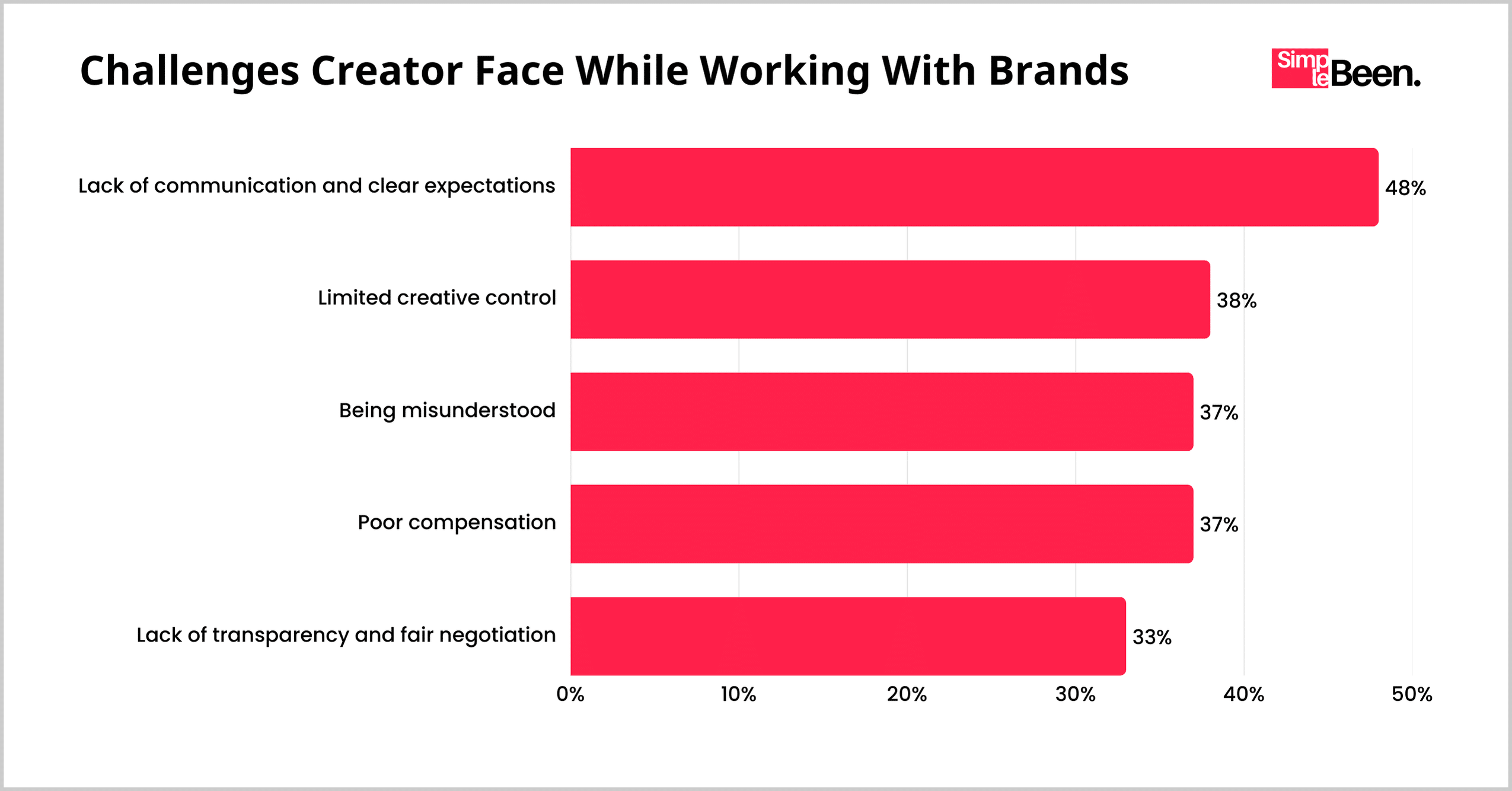
When working with brands, creators struggled with:
- Lack of communication and clear expectations (48%)
- Limited creative control (38%)
- Being misunderstood (37%)
- Poor compensation (37%)
- Lack of transparency and fair negotiation (33%)
While brand deals offer a promising revenue stream, unfair terms and miscommunication make them difficult to navigate.
75% of creators feel that platforms punish those who don’t post constantly.
Creators don’t just compete with each other; they also battle platform algorithms.
75% of creators planned to diversify their content in 2024, but many feel pressured to stick to what works with algorithms.
Top concerns for high-earning creators in 2024:
| Top Challenges for High-Earning Creators (2024) | Percentage of Creators Affected |
|---|---|
| Inflation impacting revenue | 36% |
| Platform algorithm changes & bans | 34% |
| Difficulty in growing audience | 32% |
Source: Whop Creator Economy Statistics
Even the highest-earning creators worry about algorithm shifts and financial stability, showing that success in the creator economy is never guaranteed.
Creator Economy Trends For 2025
The creator economy is on a fast track to expansion, with the number of global content creators projected to grow at a 10-20% compound annual growth rate (CAGR) by 2028.
As competition intensifies, creators are shifting their focus towards owning their audiences rather than relying solely on third-party platforms. Many are now building independent communities, launching their own websites, and finding new ways to monetize their content directly.
With millions of creators vying for attention, standing out requires diversification and ownership. Rather than depending entirely on social media platforms, many are building their own digital spaces:
- 75% of creators who have a membership community are successfully monetizing it.
- 88% have established their own websites, allowing them to control branding, audience interaction, and revenue streams.
- 24% are utilizing Linktree or similar tools to centralize their online presence and improve discoverability.
- 15% have launched private social media channels, creating exclusive spaces for their most loyal followers.
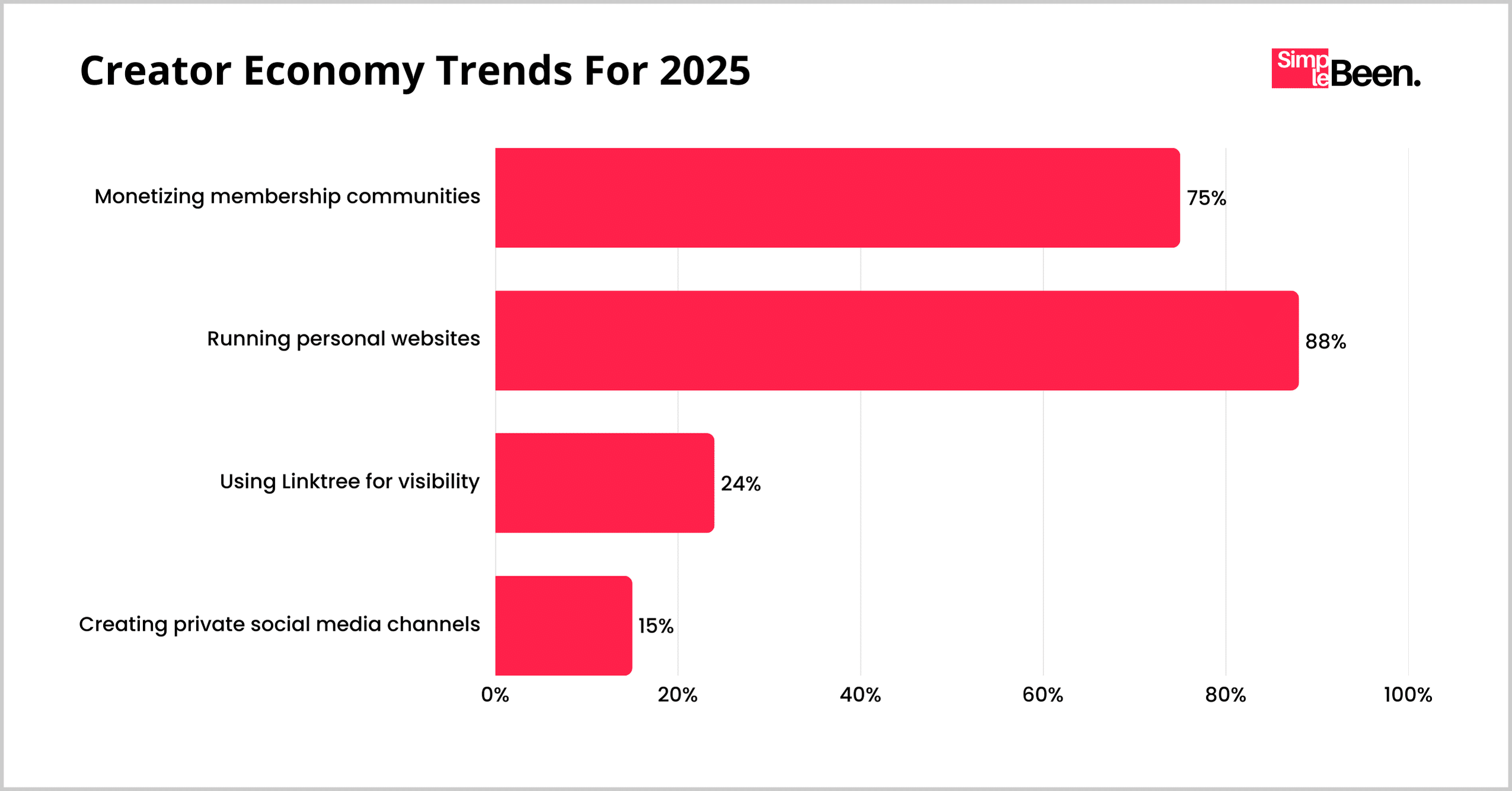
| Creator Strategies for Audience Ownership | Percentage of Creators Adopting It |
|---|---|
| Monetizing membership communities | 75% |
| Running personal websites | 88% |
| Using Linktree for visibility | 24% |
| Creating private social media channels | 15% |
The financial potential of the creator economy is set to skyrocket, with revenues projected to double to $480 billion by 2027. At the heart of this growth is digital content creation, which is expected to surpass $100 billion by 2030.
One major driver of this boom is video content, which is known for its high engagement rates and strong conversion potential. As video consumption continues to rise across platforms like YouTube, TikTok, and Instagram, creators who invest in high-quality video production are likely to see greater monetization opportunities.
Source: Whop Creator Economy Statistics
More Stats Like This:

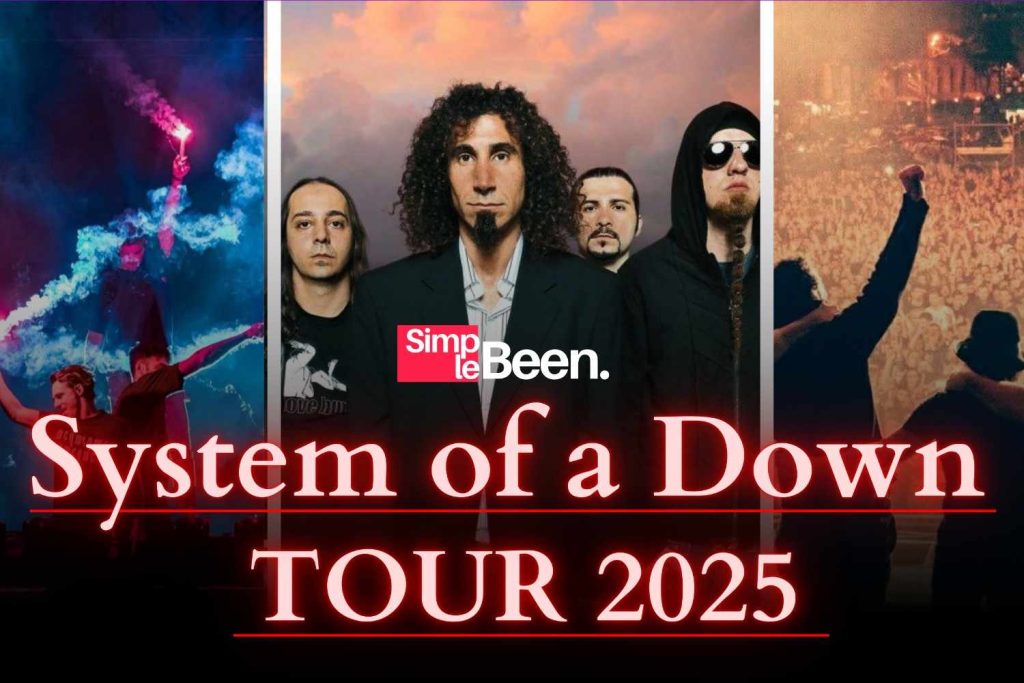

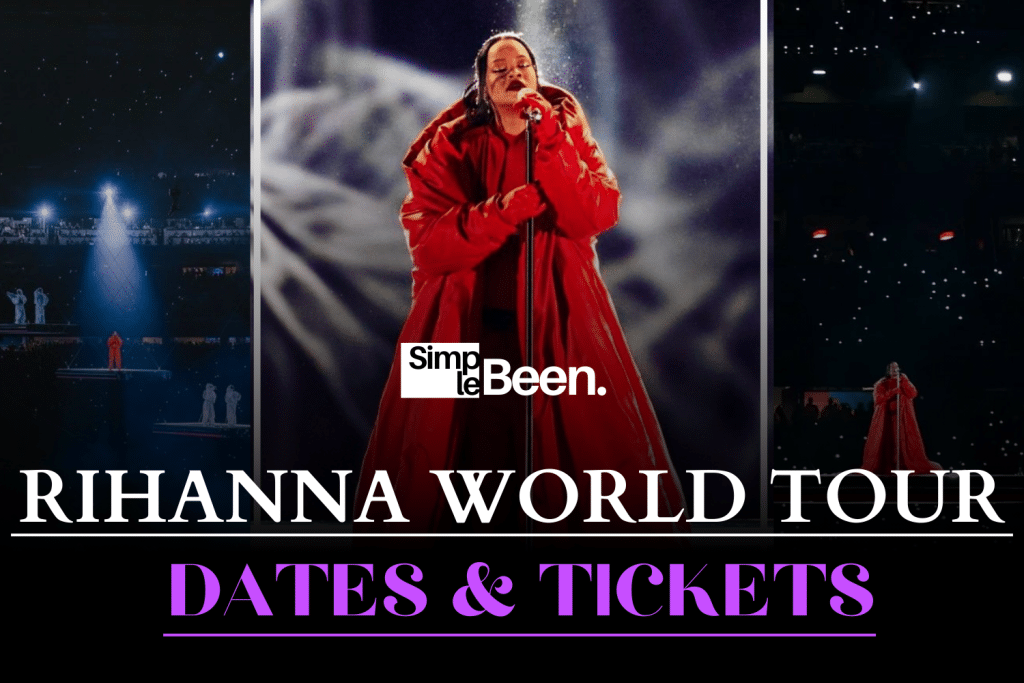




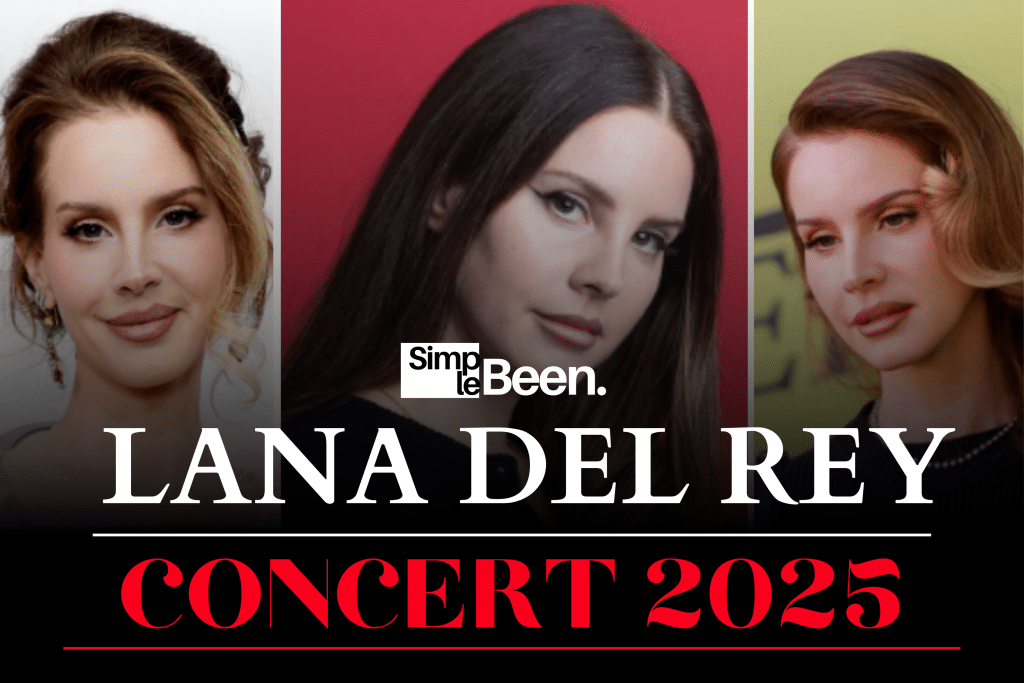

Leave a Comment